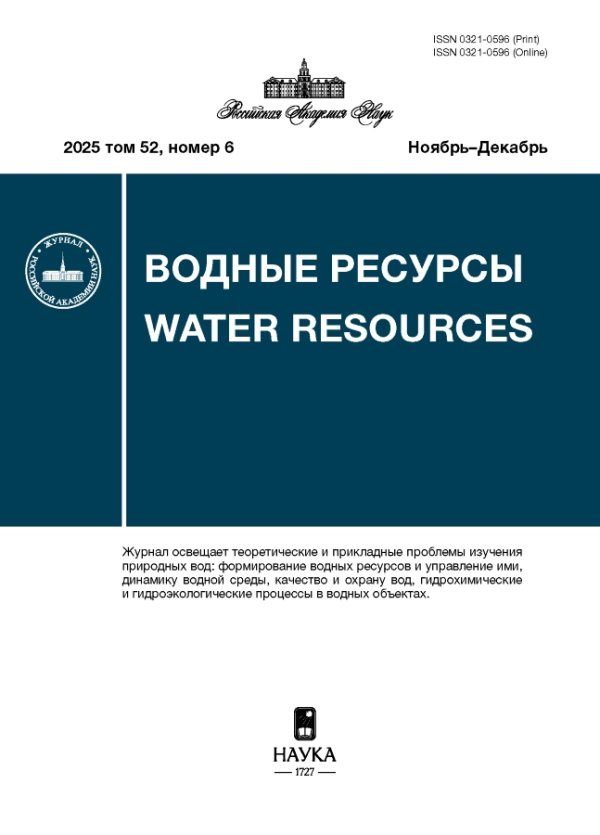Том 50, № 5 (2023)
ИССЛЕДОВАНИЯ ПРОЦЕССОВ ВЗАИМОДЕЙСТВИЯ СУШИ С АТМОСФЕРОЙ И ГИДРОЛОГИЧЕСКИХ ПОСЛЕДСТВИЙ ИЗМЕНЕНИЯ КЛИМАТА
Василий Николаевич Лыкосов (14.01.1945–10.09.2021)
 511-512
511-512


Численное исследование взаимодействия компонентов климатической системы и их роли в усиленном потеплении Арктики
Аннотация
С помощью численного моделирования и данных реанализа исследованы некоторые взаимодействия компонентов климатической системы в Арктике в условиях потепления климата. При анализе данных и результатов численных экспериментов использовался метод разложения полей характеристик состояния среды по естественным ортогональным функциям. Выявлены тенденции изменения атмосферного воздествия на систему океан–лед в период потепления и их связь с тенденциями будущих проекций потепления в рамках наиболее жесткого сценария RCP 8.5 в проекте CMIP-5. Кроме того, с помощью численного моделирования выявлена 44-летняя периодичность в системе взаимодействия общей циркуляции Северного Ледовитого океана и теплосодержания слоя Атлантических вод в нем, которая может быть связана с Атлантической меридиональной опрокидывающей циркуляцией.
 513-523
513-523


Минимальная модель Урлеманса как возможный инструмент описания горного оледенения в моделях земной системы
Аннотация
Выполнен краткий обзор основных подходов к моделированию горных ледников, по итогам которого в качестве ядра параметризации горного оледенения в моделях Земной системы выбрана минимальная модель Урлеманса. Предложенная модель основана на одномерном уравнении баланса массы ледника. Компоненты баланса массы рассчитываются с помощью специально разработанной модели орографических осадков, алгоритма коррекции приходящей солнечной радиации на наклонную ледовую поверхность, схем расчета турбулентного тепло-влаго-обмена на основе теории Монина–Обухова. Модель реализована для ледника Джанкуат (Центральный Кавказ), по которому имеется длительный ряд измерений. Продеìмонстрировано удачное воспроизведение динамики длины ледника за период 1985–2020 гг. на основе измеренных значений баланса массы: –13 м/год, что практически идеально согласуется с натурными данными. Это означает, что модель Урлеманса может использоваться как основа для параметризации в моделях Земной системы. Результаты моделирования с рассчитанным балансом массы показали существенный положительный тренд абляции при мало меняющейся аккумуляции, что также соответствует реальности. Однако при этом значения годового слоя стаивания и сокращения ледника превышают реально наблюдаемые в 2 раза. Дальнейшее развитие модели (добавление блока снежного покрова, учет моренного чехла и горно-долинной циркуляции) позволит устранить эти недостатки.
 524-537
524-537


Ожидаемые изменения испарения в XXI в. в зоне тайги Европейской ЧАСТИ России
Аннотация
Выполнены модельные оценки изменений фактического испарения бореальных лесов таежной зоны Европейской части России, обусловленные эволюцией климата в XXI в. Прогноз изменений климата выполнен на основе расчетных данных региональной климатической модели ГГО. Пространственная и временнáя детализация прогностических данных проводилась с помощью модели атмосферного пограничного слоя. Исследовались вариации прогнозируемых изменений, обусловленные использованием разных методов расчета испарения. Расчеты на основе дополнительного (взаимодополняющего) соотношения, определяющего фактическое испарение с использованием стандартных метеорологических параметров, сопоставляются с наблюдениями и расчетами на основе детальной модели энергопереноса в лесном массиве. Модельные значения фактического испарения в XXI в. увеличиваются на всей территории Европейской части России. Анализируется влияние интенсивности засушливых периодов на эволюцию фактического испарения. Показано, что, несмотря на увеличение аридности климата, влияние засушливых периодов на таежные леса будет умеренно негативным.
 538-549
538-549


Влияние московского мегаполиса на осадки теплого периода в зависимости от крупномасштабных атмосферных условий
Аннотация
Оценено влияние Московского мегаполиса на осадки разной интенсивности в различных физико-синоптических условиях. На основе анализа многолетних стандартных наблюдений на метеорологических станциях Московского региона и данных реанализа высокого разрешения ERA5 за период 1988–2020 гг. показано, что наибольшее влияние города на интенсивные осадки достигается в случаях с повышенной статической неустойчивостью атмосферы в сочетании со слабым крупномасштабным потоком, высоким влагосодержанием атмосферы и отсутствием выраженных фронтальных зон в регионе. В среднем за исследованный период превышение сезонной суммы осадков в Москве относительно фоновых значений по Московскому региону составляет 5.3%, при этом отмечено разнонаправленное влияние города на осадки разной интенсивности: ослабление (статистически незначимое) над городом осадков малой и средней интенсивности, усиление наиболее интенсивных осадков (выше 95 процентиля), повторяемость которых в Москве на 11.6% выше фоновой.
 550-560
550-560


Использование данных дистанционного зондирования при моделировании водного и теплового режимов участков суши: обзор публикаций
Аннотация
Представлен обзор результатов оценки влажности поверхности почвы, ее влагозапасов и эвапотранспирации как элементов водного и теплового режимов участков поверхности суши различных пространственных масштабов при использовании данных дистанционного зондирования Земли разных спектральных диапазонов. В большинстве приводимых примеров такие оценки были получены с помощью моделей взаимодействия земной поверхности с атмосферой. Отдельный раздел посвящен результатам расчета влажности поверхности почвы и влагозапасов при использовании спутниковой информации микроволнового диапазона, в том числе данных радаров. Приведены результаты оценки влажности поверхности почвы с помощью нейронных сетей. Кратко описаны международные гидролого-атмосферные эксперименты, проводившиеся в рамках всемирных исследовательских проектов с целью получения информации о процессах влаго- и теплообмена между подстилающей поверхностью и приземным слоем атмосферы. Сделан обзор баз наземных, спутниковых и модельных данных, формировавшихся по результатам исследований по описанной тематике с середины 1980-х гг. Представлены перспективы дальнейших исследований, опирающихся на разработку новой мультиспектральной аппаратуры, создание новых баз данных и использование нового поколения спутников – микросателлитов глобального покрытия с датчиками высокого разрешения.
 561-584
561-584


 585-601
585-601


Параметр шероховатости мелководных водоемов
Аннотация
По результатам измерений характеристик атмосферной турбулентности получены параметризации для расчета динамического параметра шероховатости и параметров шероховатости для температуры и влажности для мелкого замкнутого водоема. При средних скоростях ветра расчеты по формуле Чарнока соответствуют результатам наблюдений, при этом параметр Чарнока в три раза выше, чем в условиях открытого океана, и переход от вязкого механизма к волновому происходит при больших скоростях ветра, а параметр динамической шероховатости при тех же скоростях ветра больше. Параметры шероховатости для температуры и влажности при скорости ветра от 0.5 до 3 м/с не равны друг другу. Эмпирические коэффициенты в уравнениях, представляющих отношение динамической шероховатости к параметру шероховатости для температуры (влажности) от числа Рейнольдса, близки к полученным ранее для других замкнутых водоемов, что свидетельствует о едином механизме формирования процессов переноса в вязком подслое. Полученные параметризации могут быть использованы в моделях Земной системы и озерных моделях для расчета турбулентных потоков над водными объектами суши.
 602-612
602-612


О параметризации прозрачности воды в природных водоемах
Аннотация
Представлена новая параметризация, описывающая пространственно-временнýю изменчивость прозрачности воды, измеряемую диском Секки, в зависимости от интегральной биомассы фитопланктона и температуры верхнего слоя воды. Параметризация верифицирована по данным натурных наблюдений в разнотипных по своим физико-географическим и химико-биологическим характеристикам озерах – от глубоководных олиготрофных северных районов Ладожского озера до мелководного гиперэвтрофного Псковского озера. Результаты верификации свидетельствуют о том, что новая параметризация может использоваться при решении широкого круга как гидротермодинамических, так и гидробиологических задач. В частности, при моделировании термического режима водоемов параметризация может использоваться для оценки коэффициента экстинкции солнечного излучения. При разработке моделей функционирования водных экосистем новая параметризация может применяться для оценки толщины трофогенного слоя, а также при оценке первичной продукции фитопланктона.
 613-621
613-621


Численное моделирование турбулентного перемешивания в мелководном озере для периодов подледной конвекции
Аннотация
Представлены результаты численного расчета методом Implicit Large Eddy Simulation подледной радиационно-генерированной конвекции, развивающейся в покрытых льдом водоемах умеренной зоны в конце периода ледостава. Важность изучения радиационно-генерированной конвекции обусловлена ролью, которую играет этот феномен в температурном режиме озер и функционировании озерных экосистем в конце периода ледостава. Моделирование проведено с использованием конечно-объемного программного кода SINF/Flag-S, разработанного в СПбПУ. В расчетах использовался алгоритм SIMPLEC со вторым порядком точности по времени. Дискретизация конвективных слагаемых выполнена с использованием схемы QUICK. В результате расчетов изучено изменение температуры и пульсационных компонент скорости с периодически изменяющейся интенсивностью внешней накачки энергии в течение суточного цикла. Проведены оценки диссипации кинетической энергии, базовой потенциальной энергии, потока плавучести, а также рассчитано изменение этих величин в течение суточного цикла радиационного воздействия. Оценена эффективность перемешивания столба воды при развитии радиационно-генерированной конвекции в расчетной области, имитирующей малое озеро, покрытое льдом.
 622-632
622-632












